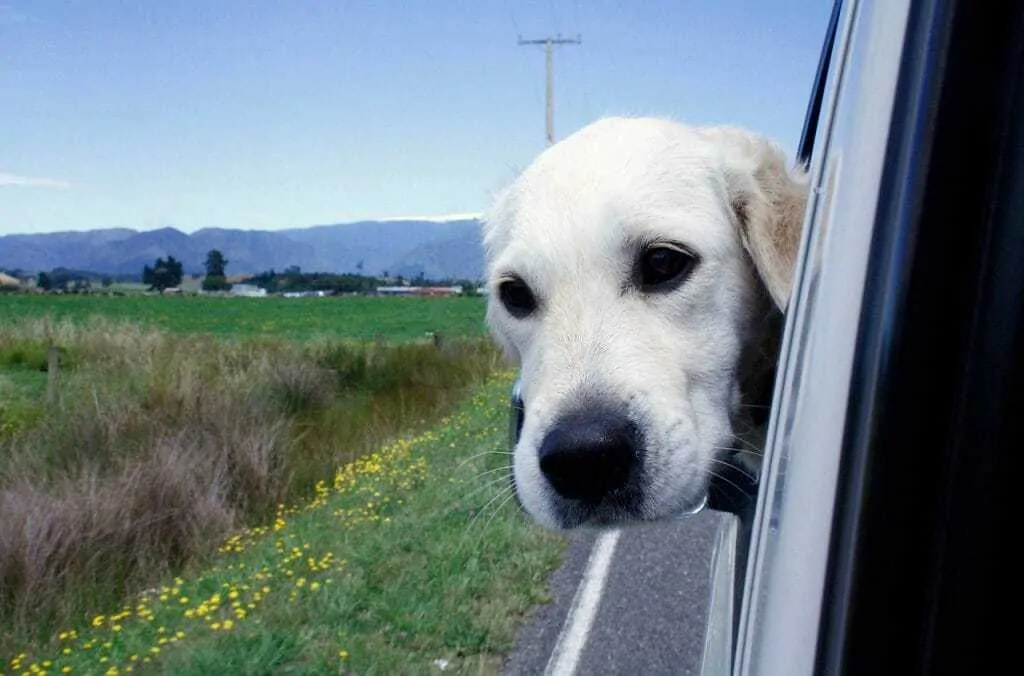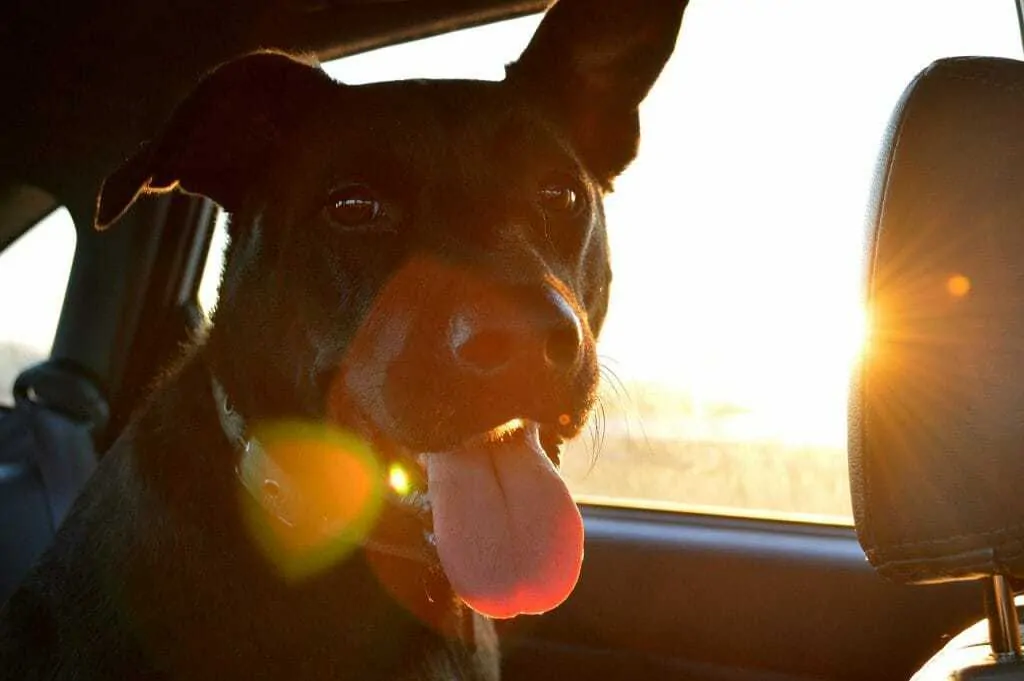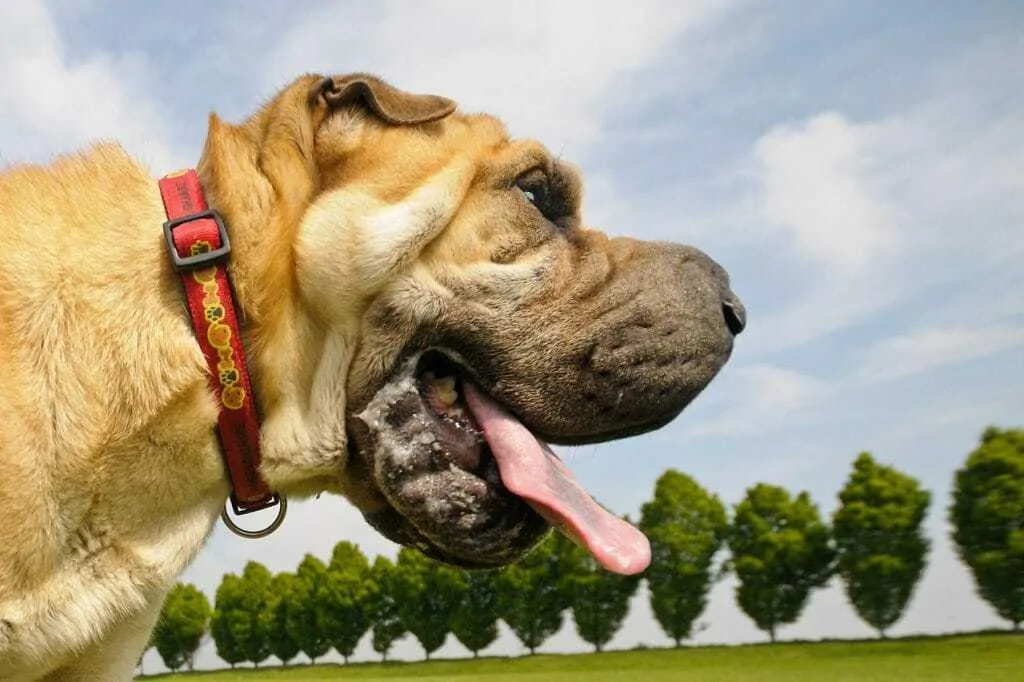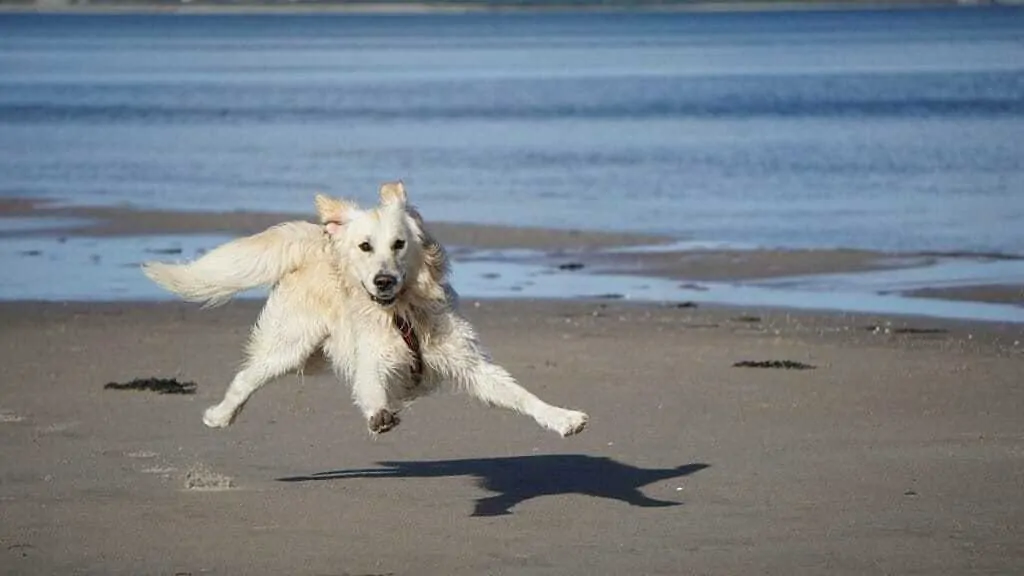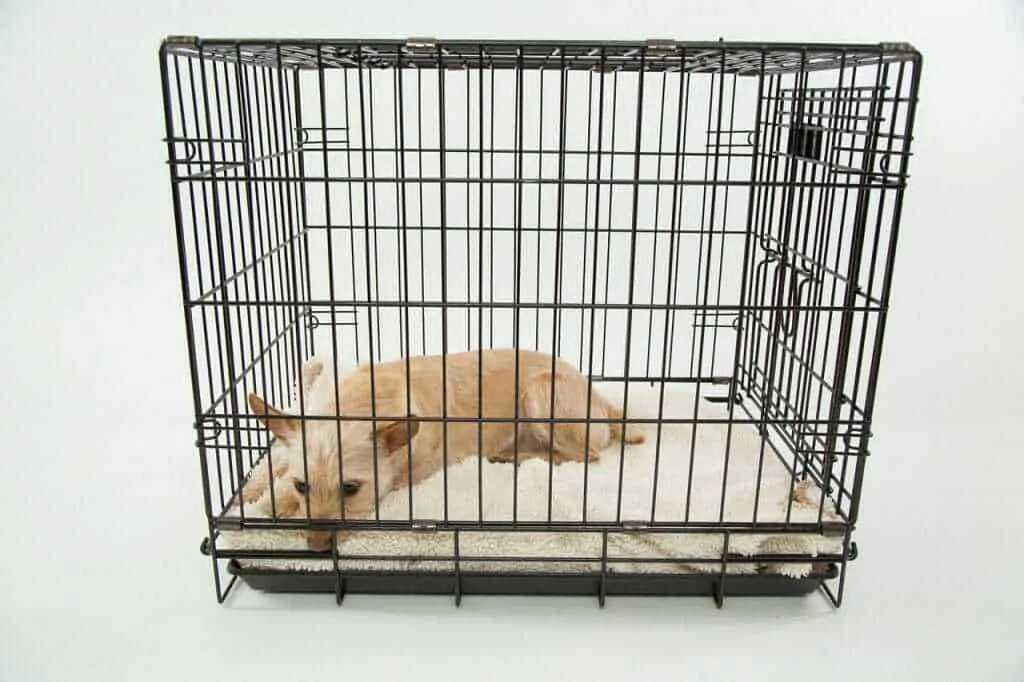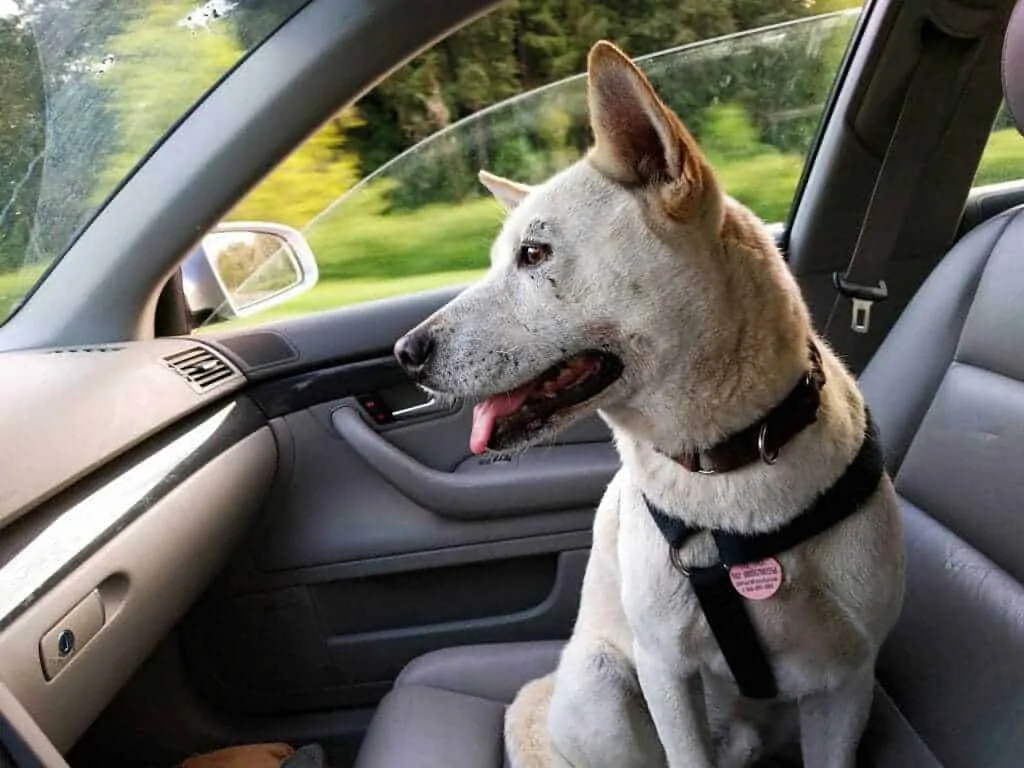You have a new dog and you can’t wait to take them to your favourite hiking spot or on a camping trip. You get all organised and ready to go and then your dog is terrified of getting in the car. You keep trying until they get themselves really stressed out. Eventually they are in and off you go. Ten minutes down the road and they are drooling excessively and shaking, this isn’t what you had in mind but you hope that they will get over it and you keep driving. Another half an hour down the road and they are violently sick all over the back of your car.
Or, perhaps you have a new puppy and your daughter wants to keep the pup on her lap in the passenger seat, your daughter is distracted by something out the window and she lets pup go and in their enthusiasm to say hello they jump on your lap and start trying to give you kisses whilst you are driving at speed.
It is really important to take the right safety precautions and also implement the right training to maximise your dog’s comfort during a car journey. Some things are simple and are just about common sense, others may require more forethought and planning. We have provided a guide to helping keep your dog comfortable and secure in the car below.
Set your dog up for long term success in the car. Keep them safe, secure and contented
Contents
1. Understand the Difference Between Motion Sickness and Anxiety Related Problems
Sometimes the drooling and trembling described in the example above can be because your dog is extremely anxious but it can often also be because they are suffering from motion sickness. It is important to work out what is triggering the reaction in the dog as they will both require different plans to solve the problem.
2. What Can Help My Dog Cope with Motion Sickness?
If a dog has motion sickness they will likely not be showing any signs of anxiety before getting in the car and when they are just sitting in it whilst it is stationary. The problems will only begin once the car is moving. The most common signs of motion sickness is that your dog will often start to smack their lips, drool excessively, appear uneasy and they can often vomit.
If you continue to force your dog on journeys without dealing with the motion sickness, because they will start to anticipate this feeling with being in the car, you can inadvertently teach them to develop a fear of travelling too.
Dogs that are suffering from motion sickness often drool excessively, sometimes even vomiting
3. What Can I Give My Dog to Reduce Their Motion Sickness?
By ensuring that your dog cannot move around too much, keeping your speed down to minimise bumps and jerks, keeping the car well ventilated and keeping them comfy, you can reduce the chances of them getting ill.
Puppies are more prone to feeling motion sickness as they still have developing inner ears and this can impact on their balance and create feelings of dizziness.
Some puppies will just grow out of it. If they don’t though, you can also try doggy safe travel sickness tablets. Some people advocate giving ginger to combat the symptoms so perhaps a little ginger biscuit before getting into the car.
If the problem is severe it may be worth talking to your vet about other prescription drug options.
4. Don’t Feed Lots of Treats to a Dog That Has Motion Sickness
Don’t forget that if your dog has motion sickness trying to give them treats or a meal before a car journey is not recommended. Make sure they are fed well ahead of time and that you keep any treats to a minimum.
If your dog suffers from motion sickness, make sure that they do not have any food directly before the journey
5. How to Help Reduce Your Dog’s Anxiety About the Car
If your dog is suffering from car journey related anxiety then anti sickness medications and keeping your dog secure will not be enough and you will need to take some more proactive training steps. They may start to get aggressive when you try to put them in the car or they may try to run away or lie down. Once in the car they may pace, pant excessively, tremble, whine or even completely shut down so that they will not react to anyone or anything.
If you sense that your dog is nervous about being in the car, you need to go right back to basics and be patient with the training.
Whilst you work on the training there are also other tools that you can use to try to take the edge off their anxiety. None of these are likely to be enough on their own but they can often take the edge off enough to make your dog more receptive to the training sessions.
You could try using a DAP Spray or Collar. These Dog Appeasing Pheromones are meant to mimic the smell that a mother emits to comfort her puppies and can sometimes ease anxiety.
You could also try using a Thundershirt. This is a specially designed, tight fitting t-shirt that is designed to apply pressure across your dogs body and this can create a swaddling effect which can comfort some dogs. If they are using this be sure that they are not at risk of overheating if the temperatures are warmer.
No products found.
6. Build up Their Time in the Car Gradually
Don’t just pick your dog up, shove them in the car and barrel off on a long journey with the idea that they will just get used to it. This sort of approach will likely only serve to heighten their anxieties and create a battle when they have to go in the car.
Start with just popping them in the car for very short periods without the car going anywhere. Make sure that you pair it with lots of super yummy treats.
If they are so nervous that they wont even take the treat rewards, you maybe have to take it back a step further and work on just rewarding your dog when they look at the car from a distance to start with.
You can then move a bit closer gradually until they are happy to be right next to the car. Then start sessions where you pop them in the car for just a few seconds and bring them out and they get a treat. Once they are happy to go into the car and anticipate a goody for doing so you can then move to shutting the car door, then having them sit in the car for a few minutes until you gradually build up to driving.
When you do start driving keep the journeys very short. Don’t do these training sessions on a hot day as being in the car even just for a minute or two without the air conditioning on can be stiflingly hot.
Your dog may feel more comfort having someone sitting beside them for these first few journeys. If this is the case and it helps them to remain calm then there is nothing wrong with doing this. Do bear in mind though that you may then have to work on gradually getting them used to sitting on their own if there are times when you might have to drive somewhere without an extra passenger to help.
If your dog is anxious in the car, start with giving then positive associations towards it before they even get in it
7. Make Sure That Journeys Frequently Result in Going to Good Places
Make sure that you don’t only ever take them in the car when they are going somewhere they might not like so much. If you only ever put your dog in the car to go to the vet and are already afraid of going there, then they may start putting the two things together and like both things less than they already do.
If your dog is mostly going in the car to get to their favourite park or the beach then they will naturally have a more positive association with it.
Make sure that most car journeys result in going somewhere fun like the beach or a woodland walk
8. Consider the Car You Are Using
If your dog has had a bad experience in a particular vehicle, maybe they have been in a bump or gone to the vet for some intrusive medical treatment, this can sometimes trigger anxiety about going into the car.
If this has happened, sometimes it can something as simple as popping them in another car for a bit. If you are a multi car household it can be worth checking whether this may be a quick fix solution to a problem that has just surfaced.
9. Think About the Noises and Environment You Are Exposing Them Too
If you have a dog that is anxious in the car and they are stuffed in the back with three noisy and rambunctious toddlers, this is not likely to help. When you are working on helping to reduce your dog’s negative reaction to car journeys, try to create as peaceful and calm an atmosphere as possible. Don’t only go in the car when you have to get somewhere, set up training sessions specifically and try to work with them one-to-one to start with. If you have music playing in the car, why not try the classical music radio channel turned on low. A hard rock channel on high volume is not likely to create a soothing atmosphere.
Whilst working on getting your dog used to the car try to work on it one-to-one. Don’t expect their anxiety to reduce when the car is full of excitable children or lots of loud music
10. Keep Them Safe and Secure
Whether your dog is anxious in the car or not, it is vitally important that your dog is kept secure or restrained. In some countries it is a legal requirement and, regardless, it is much safer for the dog, the driver and any passengers.
If you have to brake harshly and suddenly, your dog can get injured much more easily but there is also a chance that they can injure the driver or passenger if they fly forward and hit them from behind.
They can also be a distraction if they are free to roam. They can try to climb onto a drivers lap, try to squeeze out of a partially opened window or get access to things they perhaps should not. Maybe you have a bag of shopping and there are foods that are toxic to your dog that they can grab.
There are a variety of different options available for keeping your dog secure in the car including the following:
a) A Crate or Dog Carrier
A Dog Crate is my choice of car restraint. If your dog is used to going in a crate already then it will likely help them to feel relaxed. If they are not then you may need to spend some time getting them adjusted to being closed in one.
Whilst the crate takes up more space than some options, if you have the room then not only do they have the space to be comfortable and have some freedom of movement but it stops them from distracting the driver and will keep them and you more safe if there is an accident.
Smaller dogs may settle in a pet carrier rather than a crate, this can be easier to transport and can be useful for taking into the vets or on public transport too.
Make sure it is well ventilated and properly secured in the car.
Dog crates can be a great way to keep your dog safe and secure in a car. Just make sure that they are used to going in one and are relaxed first
b) A Car Harness
These are usually a stronger harness that is attached using a adapter into the plug of the seatbelt and it stops your dog from being able to roam and also keeps them more secure if there is an accident.
It is important to get one that has been crash tested for strength, like the Kurgo car harness, and some have more room for your dog to move than others. Some dogs do not like the restrictive nature of this type of product and, in this case, a crate may be a better option.
No products found.
c) A Boot Guard
For the bigger breeds or multiple dogs, it can be useful to have a boot guard so that you can pop your dogs in the boot and they will not be able to jump through to the back seat. It keeps them in a more enclosed area for safety, if they are big mucky dogs it keeps the dirt largely contained to the boot and if you don’t have space for multiple crates, it can be a good space for more than one dog (as long as they get on well enough to be put into this small space together).
No products found.
d) A Booster Seat
For small breed dogs there are little booster seats that allow your dog to sit in an elevated position in the back seat, so they can see out the window, and these also have attachments to keep your dog more secure and restrained. If these are being used with your dogs own normal harness be aware that they will likely not have been strain tested so won’t be as foolproof as a car harness designed for this purpose.
No products found.
11. Keep the Temperature Just Right
It is really important that, especially on hot days, you make sure that the car is well ventilated to avoid your dog becoming uncomfortable or overheating. If they are already nervous in the car, getting too hot will likely only exacerbate the problem.
Use the air conditioning when appropriate, have the windows open (but be sure that there is not any risk of your dog escaping) and consider using a cool coat or a cool mat for your dog to help them from getting too hot.
As we always advise, NEVER leave your dog in a stationary car on a hot day. The car can heat up to dangerous levels in a matter of minutes and dogs cannot regulate their temperatures like we can. Keeping your dog cool on hot days is vitally important and car safety is one of the biggest issues.
Even with windows open, a dog can become quickly overheated on hot summers days
12. Keep Them Hydrated
This is especially important for a longer road trip. Make sure that they have access to water when needed. There are bowls designed for using in the car so that your dog can have access all the time and not just when you stop for a break.
The Road Refresher is a bowl that should not leak even if tipped over and it can also be secured with velcro to the boot carpet.
If you don’t use something that they can access throughout the journey, make sure that you make plenty of pit stops and use a travel bowl to allow them the opportunity to quench their thirst.
No products found.
13. On Long Journeys Don’t Forget Pee Breaks and a Chance to Stretch Their Legs
If you are doing a longer road trip, make sure that you factor in enough time to allow your dog some potty stops and an opportunity for them to just stretch their legs, sniff or play outside for a bit. Plan in advance and look for suitable dog walking areas on your route.
14. Keep Your Dog Stimulated on a Longer Journey
If you are on a longer trip it can also be useful to have some items that may help to stop your dog getting restless or bored in between stopping points. Perhaps you can bring along a stuffed Kong or another treat dispensing toy that works well with a dog that can’t move about too much. A frozen stuffed Kong will also help to keep them cool on a hot day. Don’t forget if your dog does suffer from motion sickness, then a foodie toy may not be the best idea though.
No products found.
15. If the Window Is Open, Don’t Let Them Hang Out
It may seem obvious but there have been a number of accidents and injuries caused by dogs that have stuck their bodies too far out of the window of a moving car and some have also fallen out or managed to escape. If you do want the window open, make sure the dog is appropriately secured. Also be careful that there is not a draft blowing directly into your dogs face for a prolonged period. Not only can debris get into their eyes but they can also suffer from ear damage if their ear flaps are bouncing around violently for a long time and ear infections are not unheard of too.
Don’t let your dog stick their head out of a moving car window, not only can debris cause damage or possible infection but they could get hurt or worse, fall out.
(photo credit: https://pixabay.com/photos/dog-blue-sky-car-2320741/)
16. Keep Them Comfy
If you want your dog to settle in the car for a long journey it is also important to make sure they are as comfortable as possible. This is part of the reason why I like an appropriate sized crate. In a car harness, sometimes it can restrict their movement too much. Whilst you don’t want them to be able to move so much that the restraint becomes ineffective, it can sometimes impede on their ability to lie down or sit in certain positions. For a long journey this is not ideal.
Make sure they have a comfy bedding, space to move and perhaps even have a favourite toy or blanket too.
17. Be Mindful of Your Driving Style
If you have a fast or aggressive driving style, you should try to tone things down when you have your dog in the car. Lots of jerking, sudden breaking, going round corners at higher speeds can make it more difficult for your dog to settle and it puts them at greater risk of being injured.
18. Use a Ramp for Large Breed Dogs with Mobility Issues
If you have a large breed dog and they are getting on in years and struggle with their mobility, it may be worth investing in a dog ramp to take any pressure of them, or you, if you have to lift them up into the car. This is especially relevant for four wheel drives and other vehicles which have a more elevated position.
You may need to get your dog used to using it but it can take a lot of pressure off.
No products found.
19. To View or Not to View?
Some dogs love a car journey and like nothing better than being able to see out of the window. It keeps them more stimulated and they are less likely to become restless. For these dogs, as long as they are appropriately restrained and can’t stick their head out the window, it may be better to use a car harness or a booster seat for small breed dogs.
There are other dogs that may get worse motion sickness when they watch the world whirl by. Some excitable or reactive dogs may get over aroused by looking out the window. They may see other animals, cars or other objects as that set them off and could bark and whine incessantly. It is distracting for you and it is also not good to allow them to get so worked up.
Whilst it is obviously a good idea to work on training your dog not to have these sorts of reactions, as a management tool you can buy car window screens to cut out their view or they can go in a crate or in the boot to make sure they have a restricted view. They can also help to keep temperatures down when direct sun is shining in the window.
No products found.
20. Keep Some Handy Emergency Supplies
It is always good to keep some handy, often used, items in the car on a longer journey. Make sure you have spare poop bags, a spare lead, wet wipes, perhaps an emergency meal, a travel bowl and possibly a car seat cover if you want to stop the back seats from getting scratched, or hairy or dirty. You can also get dog hammocks. These cover the back seat and then come over the back of the front seats too. They should not be used as a restraining tool, they are not fool proof enough for that, but if you have a mucky dog in the back that shakes, it saves things from getting so mucky.
You can also get boot guards that work in much the same way as the hammocks.
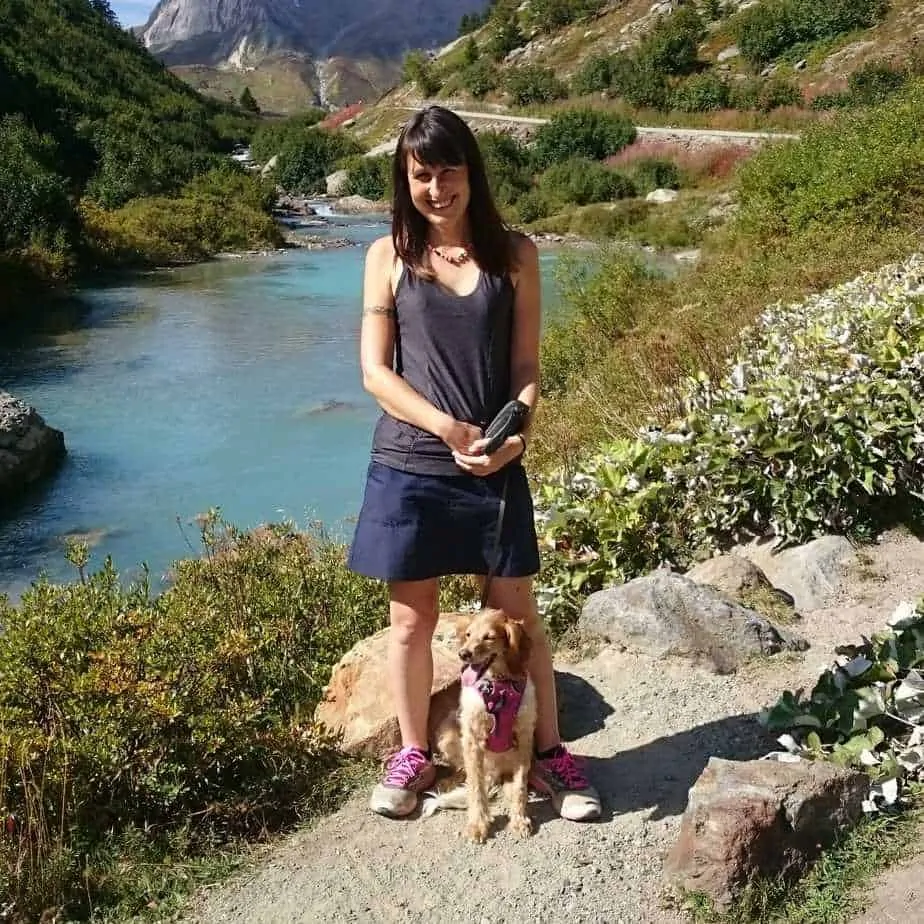
Gemma is an official dog nut and passionate traveller. Originally from the wonderful city of Edinburgh in Scotland, Gemma is now wandering across Europe with her rescue dog Annie. For ten years Gemma loved being surrounded by all things canine 24/7 whilst she ran a specialist doggy shop. The shop was a great community hub and, along with working closely with local rescues, Gemma provided customer support relating to canine behaviour and nutrition. It was a passion project and one that Gemma felt privileged to have created. She is also studying towards an Advanced Diploma in Canine Behaviour and is a huge advocate of dog rescue and promoting scientific methods of dog training.
